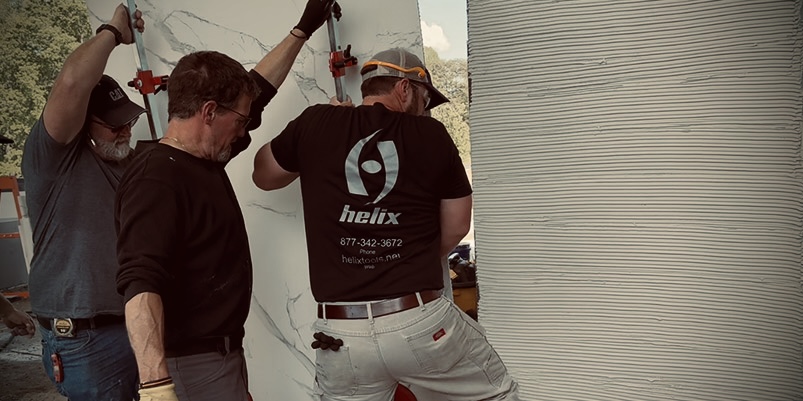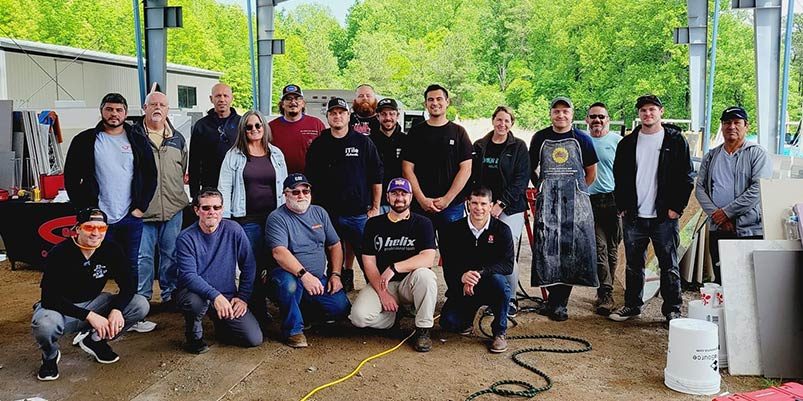
Little Secrets: Scoring a Clean Break From GPTP Hesitation
Gauged porcelain tile panels (GPTP) have been around long enough to create a demand, but many tile installers have yet to even attempt, let alone master the art and science of GPTP installation. On one hand, GPTP installation brings the opportunity to make more money and take your business to the next level. On the other hand, even the most experienced installers have doubts about whether investing in the tools, equipment, and training will actually pay off. The panels are huge, very expensive, and break easily.
Which trainings should installers attend? All of them.
I reached out to Jeff Occhipinti, owner of Columbia River Tile & Stone, to request his insight into the GPTP training ecosystem. Here is a paraphrased synopsis of what Jeff had to say:
All of the different forms of GPTP trainings are beneficial in one way or another. The more training and experience you get, the better off you’ll be.
GPTP trainings that have only one manufacturer of tools and one manufacturer of setting materials tend to be very specific and limited. The instructors want to promote their products. Reps who don’t do real-world applications are going to focus on specific straight cuts. Occasionally, these trainings do not go very well, with more porcelain breaking than successfully being installed. Even so, installers get a lot of good, sound information about materials and a chance for some hands-on practice. Learning takes place when mistakes are made.
With the longer, paid Tile Nation GPTP trainings, students get extensive hands-on instruction in handling, scoring and snapping, mitering, and epoxy techniques.
Pasha felt that there were not enough trainings available, and he really wanted to create free training events that included a wide variety of tools and materials.
Installer-led trainings are valuable because they are based on methods learned through trial and error. Here are a couple of examples.
Polished panels are notoriously difficult to work with. Lee Grundmeyer, Durend Construction, tried using a small wheel to score a polished panel and a breaker meant for 20 mm porcelain panels, and then “all of a sudden we started having major success.”
Polished panels chip very easily. Pasha loves to share his tip for avoiding chips: He uses a thick glass blade for the initial, shallow cut and then cuts along the same line with a thinner porcelain blade. With instructor-led trainings, consecutive trainings may expand upon previous ones, incorporating “little secrets” discovered along the way by anyone, even entry-level people.
Little Secrets
One thing that always strikes me while listening to installers share their clever discoveries is the use of the word secret (or as Jeremy Barker says, “fucking sorcery”) to describe technical details that can have a huge impact on the success of an installation.
The universe presents people who gain some specialized knowledge or insight, whether by happy accident or purposeful experimentation, with an important decision: They can make sure the information becomes readily accessible to those who need it most, or they can withhold the information and use it to leverage a competitive advantage. I touched on this in Hey, tile installer. What’s your scorecard?
We live in a capitalist system, where having a competitive advantage can make the difference between thriving and surviving. We all want to help each other. We all want to thrive. The two concepts seem to be inherently opposed. It’s a tricky situation, for sure, and one that won’t be resolved easily or any time soon.
I reached out to Pasha to specifically ask whether I had his permission to share with the masses his glass blade technique or anything else from the training. Pasha said his goal is to educate professionals who really care. “It’s not about my name,” he said. “It’s about making sure people know about good methods.” We had a discussion about the importance of collaboration, innovation, and trust between those who figure out new and better methods. To be sure I understood him correctly, I restated my request to share information from the training. He replied, “I would be only happy. You can share anything. It’s all good.”
Overcoming GPTP Uncertainty
In the summer of 2020, I was in the middle of a project for a GC in Portland, OR. It turned out that the customers changed their mind and decided to do Daltile Panoramic 6 mm large format tile panels on their primary shower walls and ceiling instead of the 12×24 that they originally picked. I told the GC that since I didn’t have the equipment, I would help him find a good contractor to do the work. But shortly after I realized that it was actually a great opportunity for me to start working with GPTP, and I told him I accepted the challenge. Then, I rented the snap cutter and the rack from Rob Melquist and followed his instructions on how to make my own flat and solid work table.
Answering the Call to Up Your Game
Pasha recently invited installers to attend a free, two-day training for Dekton and GPTP installation at Rozelle Stone in Easley, South Carolina. Panels were donated by Noah Chitty, Crossville, Rick George, Daltile, and Rudi Russell Bruno and Josh Magni, Consentino. Other donations included shower modules from Cornel Seicean, Revolutionary Shower Systems, and Monolit equipment and tools from John Roberts, Gundlach. Food was provided by Daltile and Schluter. Scott Carothers, Ceramic Tile Education Foundation (CTEF), and Joseph Mattice, Schluter, gave technical presentations.

(Left to right, standing) Rafael Ferreira, Mike Hayes, Pasha Hushtyuk, Alice Dean, Jeremy Barker, Mike Maness, RC Heidler, Vince Parker, Dylan Abreu, Jennifer Barker, Pasha Starykov, Scott Pass, Mitchell Loy, Jesus Rios, (kneeling) Justin Hardy, Anthony Rouse, Mike Smith, Bob Atchley, Rick George.
Classroom Takeaways
- Know the code in your area.
- Use the same manufacturer from start to finish on a project, if possible.
- For GPTP, it is in the standard itself to do the prep. There is no reason installers shouldn’t get paid for prep.
- Concrete is sealed to slow cure rate and prevent curling, so to ensure proper adhesion, you should prime it with a specialized bond-promoting primer.
- Understanding material science is important. Go to manufacturer websites and read tech sheets.
- You first priority is to check the project area with a 10 ft. straight edge, adding inches for the rack, or bring in a template. These lightweight tools will help you easily identify logistical limitations.
- GPTP installation isn’t just about cutting, it’s about how well the material will snap off without chips.
- Consider how GPTP deflection works. The weight of a panel doesn’t go straight down, it goes out.
- The basic tools you need to get started with GPTP installation are a rack, table, and snap cutter.
- Electric vacuum suction cups may cause micro fissures in 3+ mm panels. These tools are great except for that specific thickness.
- Helix Hellion and Porcelana Dura are good blades.
- Don’t use cordless tools, because there is not enough speed.
- The lower the grit, the higher the speed; the higher the grit, the lower the speed.
- Use flexible cementitious mortar when you bring two pieces together.
- A tension strip or edge profile can be used as the outside edge. Another option is to cut and polish.
- Wait until you are at the project site to cut panels in case of damage in transport.
- Ramondi cutting wheel runs on both sides.
Attendee Feedback
Bob Atchley, Tile ProSource attended the class because he enjoys getting “honest feedback from the guys that are out there in the field working on these products day in and day out.” After seeing Pasha’s clever approach to cutting polished panels, Bob said, “I need to make sure to have a 5-inch glass blade in stock at all times, because of the way they are penetrating the top layer of these slabs to provide chip-free plunge cuts.”
From Bathematic Custom Tile and Shower, Jeremy Barker said he really enjoyed the class. “We’re always trying to innovate and cultivate our knowledge for our industry. We were so proud to be there. […] It’s always great to be amongst people in the industry.” Jennifer Barker said, “It was such an honor to be the only woman tile setter there amongst many legends in the tile industry. It was amazing to be able to learn all of the processes about installing large panel tile, and I hope to be able to use that in the future with our company. Big shout out to Pasha for be able to take time out of his work schedule to come and teach us. It was such a pleasure.”
The Courage to Leap
"Gauged panels are very challenging, but they're absolutely feasible. You simply have to have a bona fide strategy, respect, and let's say, the courage to leap."
Vince Parker
Vince: “You're gangster, Pasha.”
Pasha: “Anyone can do this.”
Vince: “You’re still gangster, Pasha.”
